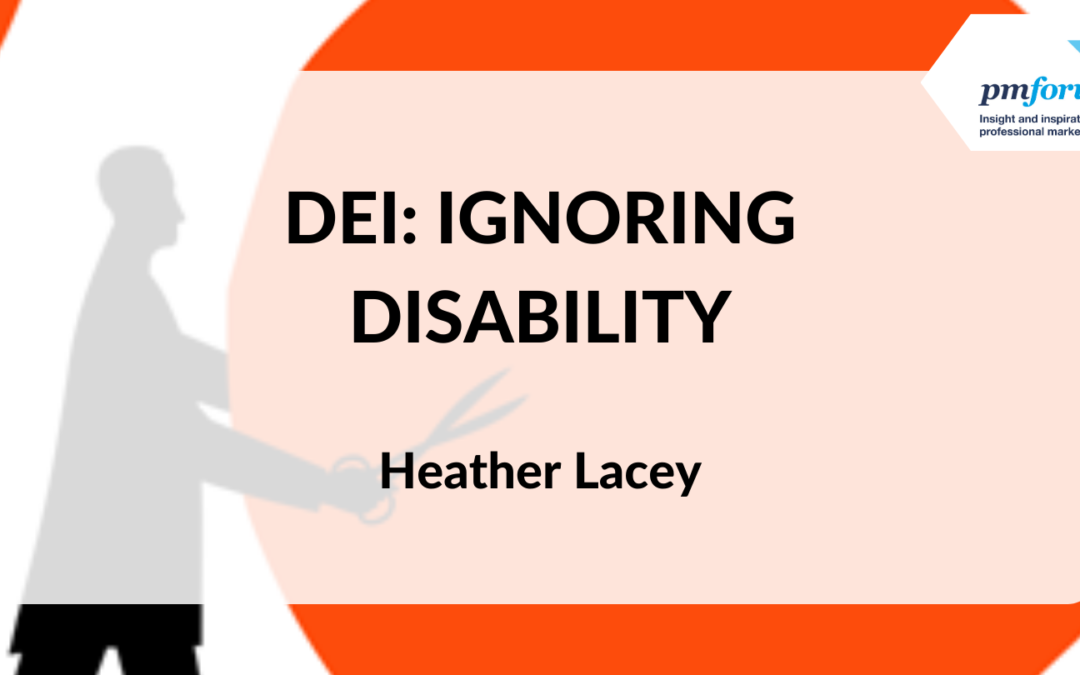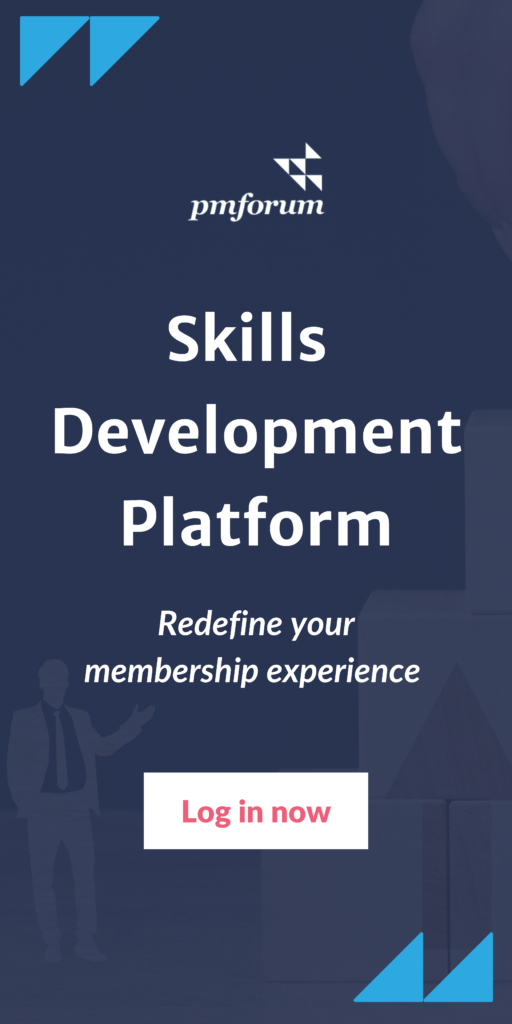Diversity, equity, and inclusion policies all too often overlook disability. Marketing and business development teams are poorer for it, writes law firm marketer and disability advocate Heather Lacey.
The global pandemic has irreversibly changed the way we work, with most of us now finding a balance that fulfils the needs of business and the lives we lead. It has also turned the spotlight on the very real inequalities and contradictions within our communities, bringing inequalities of race, gender and disability into even sharper focus. No matter how we try to uphold a sense of pre-pandemic normalcy, it is clear the world has changed, and its citizens are scrutinising their place in it and demanding more from every area of their lives.
Upholding these personal values has bled into commercial enterprises and increasingly dictates where people purchase their products, how they choose to spend their time, and which suppliers they agree to procure goods or services from. Businesses are having to wrestle with this increased social consciousness and ensure they must not fall foul of any DEI faux pas at any cost.
Businesses can no longer just be seen to be supporting DEI initiatives but must also answer to what is happening behind the scenes, i.e. what is happening where the diversity and inclusivity-focused messaging is emanating from. We see more and more expectations for businesses to engage in initiatives regarding gender, race, and LGBT+, and yet there is one protected characteristic that always seems to be kept under wraps, hushed up and away from sight, as well as disregarded in mandatory equality monitoring measures: disability.
The World Health Organization reports that globally 16% of the population lives with a disability – which by all accounts is a conservative estimate, with many disability charities suggesting the figures are likely closer to 20%. Disability is a unique protected characteristic in that it cuts across every other diversity measure and doesn’t, by its very nature, discriminate (though of course, socio-economic variables may increase the likelihood of some conditions).
As the population continues to age and as we see increases in medical advancements, the majority of us are likely to be at the very least temporarily disabled at some point in our lives. To deny this is no longer sensible: it is likely that if we aren’t already, a great deal of us will become at least temporarily disabled during our working lives.
Marketer and activist
I am one of those of working age falling under the former: I have cerebral palsy, a neurological condition from birth that causes, at the very least, difficulty with motor skills, chronic pain and fatigue, as well as neurodivergence – a term used when someone’s brain processes, learns, and/ or behaves differently from what is considered ‘typical’, or ‘neurotypical’.
I was one of those individuals who really reaped the benefits of homeworking – and continues to now that I work in a truly hybrid way – since I do not have the luxury of knowing how I’m going to feel from one day to the next. And if the stats on disability are anything to go by, I am far from the only one. And yet, as I sit here thinking about my experiences as a marketer in professional services, I find it difficult to talk of other disabled marketers’ experiences, particularly those who identify as neurodivergent (ND) or have what can be defined as ‘invisible’ disabilities.
The World Federation of Advertisers, in its 2021 DEI Census report and again in its 2023 interim findings, aims to highlight the differences in the lived experiences of groups across the global marketing profession, and the findings very much echo my personal story.
It found that a high proportion (71%) who identify as disabled report mental/cognitive disabilities (such as neurodivergence, mental illness and learning disabilities) but relatively few (44%) inform their employer. Even worse, disabled respondents reported living the worst work experiences in our industry overall, meaning they are more susceptible to bullying, discrimination and lack of career progression. So, what are the reasons for this?
Disability – DEI’s poor cousin?
Alongside my work as a marketer in legal services, I am an award-winning disabled activist, regularly speaking at events, on podcasts, in print, and more. Although more and more people are beginning to take notice of disability, it still feels very much like the poor cousin of DEI, both in DEI strategies more generally and in our workplaces.
The legal industry has been under the magnifying glass on this topic, with the research culminating in the Legally Disabled? report in association with Cardiff University and ESRC back in 2020. The report suggested that given the choice, disabled people in the legal profession generally don’t disclose their disability, despite these professionals having a better-than-average understanding of their legal right to request reasonable adjustments.
In an environment where high performance is expected of firms’ lawyers and thus simultaneously expected by their marketing and business development functions, ‘disclosing’ disability is likely low down on a professional services marketer’s list for fear of experiencing discrimination or simply of being greeted by misconceptions and lowered expectations. And if disabled marketers do not see themselves reflected in their leadership teams, how will they ever feel that this industry is one in which they can not only survive but thrive?
Commercially compelling arguments
Aside from the obvious moral reasons to put disability inclusion at the top of your marketing and business development strategy, there is no doubting the potential commercial ramifications for not putting disability inclusion at the top of our agenda. We know that around 20% of working-age adults are disabled, meaning that these stats apply not only to our own teams but to those of our clients. It has been documented that businesses with a diverse workforce are 35% more likely to experience greater financial returns than their non-diverse counterparts (McKinsey, 2015), meaning that diversity can genuinely have an impact on the bottom line. Not only that, businesses with increased diversity are 70% more likely to capture more markets than their non-diverse counterparts (HBR, 2013), something marketing and BD teams can truly take advantage of.
It is no longer acceptable to not have women at the table. It is no longer acceptable to not have people of colour at the table. But no one thinks to see if the table is accessible. Judith Heumann, disability rights activist
Embracing new perspectives
For a long time, disability has been seen as a weakness; something to shun and to hide away from. One of the most interesting things about working with neurotypical employees is that I may often see things from a differing perspective – there may be something else I can offer to a strategy and a different angle to help shape the ‘normal’ way of doing things. Due to my own experiences as a disabled consumer of content, I can identify whether the content may need shaping to ensure digital accessibility – these are access needs I use every day when consuming content, both at work and at home.
Resilience and critical thinking skills
Navigating a world that is ultimately not made for you – whether that’s needing a ramp instead of steps, arm rails, subtitles or screen readers – encourages seemingly boundless amounts of resilience.
My life has ultimately been shaped by my experiences as a disabled woman: it has affected everything, from navigating hospital appointments whilst taking my GCSEs, dealing with daily, unrelenting pain and fatigue, to simply ensuring I am prepared to leave the house for the day (which meds do I need? Shall I take my walking stick?). It means that my ability to deal with unpredictable situations sometimes seems limitless and my perseverance, though often tested, remains very much intact. Does this mean I sometimes have to approach my tasks differently? Absolutely. Does this stop me from doing my job well, just because I do some tasks in a different way? Absolutely not.
Consider the disabled talent pool
All things considered, there’s nothing to lose for marketing functions who decide to seriously consider the disabled talent pool. We must, however, ensure that we move the needle and do so in a way that allows our people to feel encouraged and listened to and our experiences reflected in our leadership teams.
Perhaps this means that those in leadership positions should consider whether they could be more open and honest about their experiences of disability, and ensure disability remains high up on the agenda alongside the ‘sexier’ components of their DEI strategies.
The world has changed, and we must adapt to it. There’s never been a time as good as now.
 Heather Lacey is a Marketing and Business Development Manager at Eversheds Sutherland, largely supporting the Consumer and Industrials sectors. She is a multiaward-winning disabled activist and has worked with organisations such as the BBC, Scope, AccessAble and Business Disability Forum to produce content pertaining to disability issues via podcasts, at events and in print.
Heather Lacey is a Marketing and Business Development Manager at Eversheds Sutherland, largely supporting the Consumer and Industrials sectors. She is a multiaward-winning disabled activist and has worked with organisations such as the BBC, Scope, AccessAble and Business Disability Forum to produce content pertaining to disability issues via podcasts, at events and in print.
Members only: if you want to add this reading to your CPD, please log in and complete the evaluation
Log in



